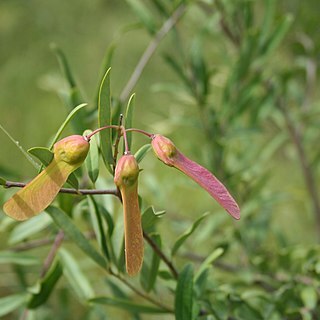Woody vines, usually scandent shrubs, or trees. Leaves alternate, entire, short-petioled, generally with corneous peziziform stipular glands. Racemes terminal or axillary, often paniculate. Flowers usually pink or purple; sepals 5, free, the outer 3 herbaceous, the inner 2 (wings) much larger, petal-like; petals 3, the lowest (keel) boat-shaped, clawed, with a plicate, fimbriate crest, the 2 upper adnate to the base of the staminal tube but distinct from the keel; stamens 8, their filaments connate nearly to the apex into a sheath split on the upper side, adnate to the keel and upper petals toward the base; anthers confluently 1-celled, open-ing by a large introrse-apical pore; ovary unilocular through the abortion of the second locule, with an appendage on one side which develops into the wing of the fruit, the style sickle-shaped, excavated apically, the stigma 2-lobed, approxi-mate, the ovule solitary, pendulous; disc a low fleshy ring at base of the ovary. Fruit a samara, the wing large, 1-seeded; seed glabrous, exarillate, endosperm wanting, the cotyledons thick-fleshy, oily.
Shrubs scandent. Leaves simple, alternate; nodal glands present, veinlets reticulate. Inflorescences racemose or paniculate, terminal or axillary. Flowers zygomorphic, small, with bracts. Sepals 5, caducous, unequal; outer 3 small; inner 2 petaloid, large. Petals 3, lateral petals and keel connate or free, keel helmet-shaped, with apical appendage. Stamens 8; filaments united in lower part, forming trough-shaped sheath open on upper side and adnate to petals; anthers 2-celled, ovoid, dehiscent by oblique pores. Disk reniform. Ovary 1-loculed; ovule 1, anatropous, pendulous; style falcate, curved; stigma short, lobed or not. Fruit usually a samara, with 1 seed; wing oblong or rhombic-oblong, leathery, veins numerous. Seed subglobose, without endosperm, without strophiole; seed coat membranous.
Fruit a samara (a 1-locular, 1-seeded, winged nut) usually 1-winged, occasionally with an additional rudimentary wing.
Small trees or shrubs, often scandent, or lianes with entire, alternate leaves.
Sepals 5, unequal, two lateral ones (wing-sepals) larger and petaloid, free.
Petals 3 (occasionally 5, two being vestigial), lowest keel-shaped.
Flowers zygomorphic, in terminal and axillary racemes or panicles.
Seed without caruncle and without endosperm.
Stamens 8, monadelphous.
Ovary 1-locular.

